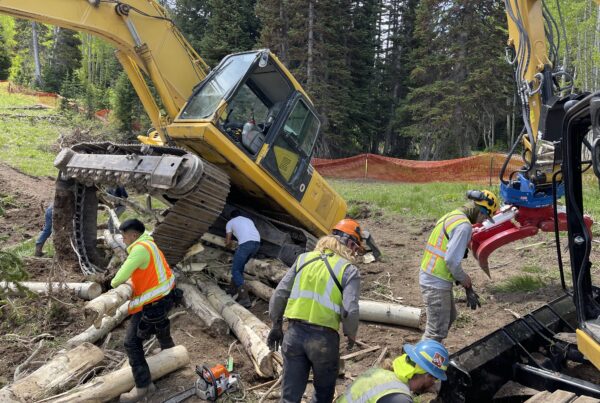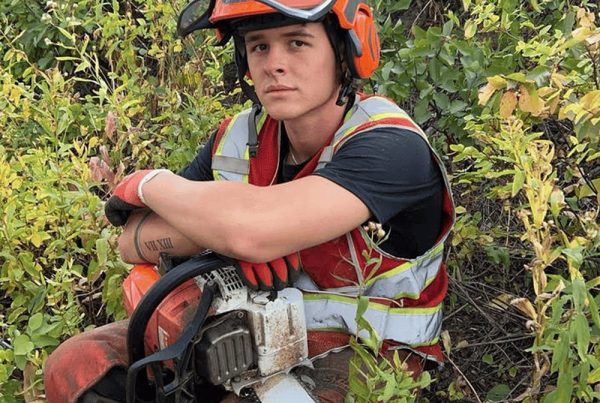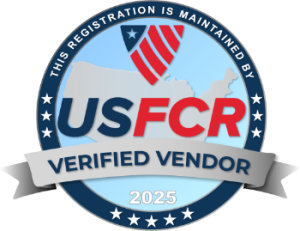Wildfire emergency kit checklist guidance matters in Park City and Heber City because evacuation can happen quickly in the Wasatch Mountains and Uinta Mountains, especially for ski-in ski-out neighborhoods near Deer Valley and Park City Mountain. This guide explains what to pack, how to tailor a wildfire preparedness kit to your household, and where Canyon Cutters fits into your property wildfire readiness.
Table of Contents
- Why a Wildfire Kit Matters in Park City and Heber City
- Canyon Cutters: Your Local Partner for Mitigation and Recovery
- Core Wildfire Emergency Kit Checklist – The First 72 Hours
- Documents, Contacts, and Communication Plans
- Tailoring Your Kit for Different Households
- Adapting Kits for Housing Types and Travel
- Winter, Smoke, and Air Quality Considerations
- Where to Store and How to Maintain Your Kit
- Printable and Digital Checklists
- FAQs
- Contact Canyon Cutters
Why a Wildfire Kit Matters in Park City and Heber City
Park City and Heber City sit in the Wasatch Back where steep terrain, strong canyon winds, and seasonal drought can push a small brush fire into a fast-moving event. Families living on or near the ski resorts often depend on a clear evacuation route and a ready set go plan that includes a wildfire evacuation kit. Your goal is to be able to leave quickly with an emergency kit for wildfire that covers 72 hours of food, water, medicine, and information. This Wasatch Back wildfire emergency kit checklist helps you do just that.
Building a wildfire survival kit goes hand in hand with creating defensible space around the home and hardening structures with ember-resistant vents, metal mesh screens, and a spark arrestor where appropriate. Together, these actions reduce risk while you assemble a wildfire readiness kit tailored to your household, pets, and property. If you manage multiple buildings or a large parcel, consider a wildfire safety kit staged in each structure for redundancy.
Stay alert for a red flag warning or a fire weather watch, and sign up for Summit County alerts and Wasatch County Emergency Management updates. Keep tabs on local guidance from the Park City Fire District and state-level resources from Utah Division of Forestry Fire and State Lands and Utah Wildfire Info. These alerts inform when to move from preparing to going.
Canyon Cutters: Your Local Partner for Mitigation and Recovery
Canyon Cutters is Locally Owned & Operated in Park City, with a primary focus on homes and property located on and near the ski resorts. We offer a complete arborist solution for residents of Park City and Heber City, including Fire Mitigation and seasonal services that protect access for emergency vehicles and residents.
- Canyon Cutters – local arborist and forestry partner
- Services – Wood Chipping, Land Management, Tree Removal, Dump Truck Hauling, Fire Mitigation, Tree Pruning, Stump Grinding, Snow Removal, Clearing Trails for Ski in & Ski Out, Erosion/Drainage Construction Solutions, Storm Cleanup, Property Rehabilitation
- Fire Mitigation – reduce fuels, open defensible space, and prepare access
- About – meet our ISA Certified Arborist-led team
- Contact – request service or an assessment
During red flag periods, our crews can prioritize access – from clearing trails for Ski in & Ski Out neighborhoods to fast debris removal after wind events – so evacuation routes remain usable. After an incident, we handle storm cleanup and property rehabilitation to help you reopen driveways, protect drainage, and stabilize slopes.
Core Wildfire Emergency Kit Checklist – The First 72 Hours
Think of this as your wildfire go bag – light enough to carry, complete enough to cover a 3-day window. Some residents call it a wildfire bug out bag or a wildfire evacuation kit. Use sealed bins for your home wildfire emergency kit and backpacks for each person’s grab-and-go bag. For reference, see CAL FIRE’s Go Evacuation Guide and the American Red Cross overview of wildfire supplies.
Water and Food
- Water – one gallon per person per day for at least 3 days (Ready.gov guidance)
- Shelf-stable food bars and non-perishables that require no cooking
- Manual can opener and basic utensils
- Pet food and water sized for your animals
Respiratory, Eye, and Skin Protection
- N95 respirator or P100 respirator for smoke and ash
- Particulate respirator spares for each family member
- Safety goggles to block embers and debris
- Fire-resistant clothing options, cotton long sleeves, and sturdy boots
- Work gloves for debris, plus a mylar blanket for warmth
Lighting, Power, and Tools
- Headlamp and batteries for each person
- Portable phone charger power bank
- NOAA weather radio to track alerts when cell service is spotty
- Whistle to signal for help, multi-tool, duct tape, waterproof matches
- Basic tool roll for quick home hardening steps before you leave
Health and First Aid
- First aid kit with burn dressings, saline, pain relievers, and bandages
- Prescription medications organized in labeled, child-safe containers
- Spare glasses or contacts and hygiene supplies
Navigation and Information
- Emergency contacts list printed and saved in phones
- Copies of IDs and insurance stored in an important documents fireproof pouch
- Paper maps of Park City and Heber City with alternate routes marked
- Small cash small bills for fuel, food, and lodging
Home Hardening Quick Steps Before You Go
- Move patio furniture, firewood, and combustibles at least 30 feet from structures (PCFD guidance)
- Shut windows and doors, leave exterior lights on, and close blinds
- Place a metal ladder against the house for firefighter access
- Shut off natural gas or propane if advised by authorities
Once the basics are set, consider upgrading to a wildfire preparedness kit with an air quality index monitor and a compact HEPA air purifier for shelter-in-place smoke preparedness. A smoke emergency kit with extra respirators, filters, and interior-seal materials can keep indoor air safer while you wait for a clear evacuation window. See the EPA’s Fire and Smoke Map for current smoke and fire information.
Households often build a family wildfire kit or a 72-hour wildfire kit that lives near the garage door, plus smaller versions in bedrooms. If your family travels the canyons frequently, stage a car emergency kit for wildfire travel with extra water, a blanket, and paper maps.
Documents, Contacts, and Communication Plans
Prepared households keep a wildfire emergency kit with medications and documents ready to grab. Store copies of IDs, titles, deeds, insurance, medical summaries, and a simple family communication plan. Include an emergency contacts list and meeting locations outside the neighborhood. Share the plan with neighbors and your HOA.
- Keep digital copies on an encrypted drive and printed copies in a fireproof pouch
- Assign an out-of-area contact everyone can text or call
- Save local non-emergency numbers for Park City, Summit County, and Wasatch County
- Post a card on the fridge with key contacts and evacuation route options
Tailoring Your Kit for Different Households
Every household is different. The following sections adapt the wildfire emergency supply list so you can pack what matters most to you, without overloading your bags.
Families and Multi-Generational Homes
Use a 72-hour wildfire go bag list for families to pack clothing layers, child comfort items, and extra food. For larger homes, build a home wildfire emergency kit near exits on each level. If you are hosting visitors during ski season, brief them on your wildfire evacuation checklist and where the wildfire safety kit is stored.
Seniors and Caregivers
A wildfire emergency kit for seniors in Park City often includes spare medications, mobility aids, and a list of medical providers. Pack extra batteries for hearing aids, large-print instructions, and an index card with medication schedules. Consider a ride plan with neighbors or family.
People with Disabilities
Build a wildfire go bag list for people with disabilities that aligns with your daily routines. Include adaptive equipment, backup chargers, and printed accessibility notes for shelters or hotels. If you rely on medical devices, add an inverter and power bank to your wildfire emergency power outage kit checklist.
Infants and Young Children
If you have small children, prepare a wildfire emergency kit for children and babies with diapers, wipes, formula, bottles, and a favorite blanket. Pack lightweight distractions and label each bag clearly so any adult can find what is needed fast.
Dogs, Cats, and Other Pets
Create a pet wildfire kit sized for at least 5 days. Include pet carrier and leash, pet food and water, litter and waste bags, vaccination records, and a photo of each animal. For multi-pet households, use color-coded totes. Keep spare tags and contact info in each carrier. A wildfire evacuation packing list with pets should also include a collapsible bowl and a comfort toy to reduce stress. For ideas, see Be Ready Utah’s pet supply suggestions.
Horses and Livestock
Ranch and equestrian properties need a wildfire evacuation kit for horses and livestock. Pre-load halters and lead ropes, keep a trailer staged with hay nets and water, and store copies of brand papers and veterinary contacts. Coordinate with neighbors for multiple-trailer moves and practice your route at low-traffic times.
Adapting Kits for Housing Types and Travel
Park City and Heber City include a mix of single-family residences, condos, ski-town apartments, and remote cabins. Use the guidance below to tune your wildfire packing list to where you live and how you travel.
Single-Family and Mountain Homes
For a mountain home emergency kit, stage bins in the garage near the vehicle, and keep a smaller bag by the primary bedroom. Add long-handled tools, tarps, and a hose nozzle for quick pre-evac tasks. If you manage a large lot, assemble an HOA wildfire kit for shared outbuildings.
Condos and Apartments near Ski Resorts
High-density buildings require a wildfire evacuation kit list for apartments and condos. Emphasize mobility – lighter bags, copies of building exit maps, and stair-friendly carts. If you own a ski home, choose the best wildfire emergency kit items for ski homes, like compact boots, layered clothing, and a spare lockbox key for caretakers. Use this ski-in ski-out property wildfire kit checklist as a reference when staging supplies for slopeside condos and townhomes.
Second Homes and Vacation Rentals
For second homes, make a wildfire go bag list for second homes in Park City that includes spare chargers, a local prepaid SIM card, and laminated instructions for guests. Vacation rental owners should prepare a wildfire emergency kit list for vacation rental owners and post a brief one-page guide near the entry.
Remote Cabins in the Uinta Mountains
Owners of remote cabins need a wildfire kit checklist for remote cabins in the Uinta Mountains. Pack extra water purification tablets, a larger first aid kit, and cold-weather layers even in summer. Because road closures can be sudden, include overnight shelter gear and a paper map with alternates through the Wasatch Mountains and Uinta Mountains.
Renters and HOA Communities
Renters should save a digital copy of the lease and insurance details in the important documents fireproof pouch. Build an emergency wildfire kit list for renters in Park City that fits in one rolling tote per person. HOA leaders can develop a wildfire evacuation checklist for HOA communities and a wildfire emergency kit checklist aligned with HOA rules, including instructions for opening gates, notifying residents, and staging equipment.
Car Go Bag, RVs, and Trailers
Keep a wildfire car go bag checklist for mountain travel in your vehicle with water, a blanket, a headlamp, and tire repair items. For adventure vehicles, add a wildfire emergency kit list for RVs and trailers with leveling blocks, extra fuel if permitted, and a weather radio adapter. In all cases, include a simple smoke emergency kit so you can mask up and continue driving safely if ash is present.
Winter, Smoke, and Air Quality Considerations
Because winter lingers and smoke can infiltrate homes, prepare a wildfire emergency kit list for winter conditions in Utah. Add insulating layers, traction devices, and extra blankets. For smoke, build a wildfire smoke prep kit with air quality tools, including an air quality index monitor, extra N95 or P100 respirators, and materials to improve indoor air – such as a HEPA air purifier for a small safe room.
Use alerts from an emergency alert system and NOAA weather radio when cell coverage drops. During heavy smoke, avoid burning candles or using vacuums and keep windows sealed until AQI improves. When it is safe to travel, move early to avoid congestion. For health-focused tips, review the EPA’s Wildfire Smoke Guide.
Where to Store and How to Maintain Your Kit
Space is tight in ski-town homes and condos, so aim for modular containers. A wildfire emergency kit storage tips for garages approach is to place labeled bins on a single shelf near the garage door. In small units, use under-bed totes and an entry closet for lightweight items. Review your wildfire emergency supply list each spring and fall, swapping expired food and batteries.
If you are a contractor or oversee multiple units, maintain a wildfire kit checklist for contractors and property managers. Standardize labels, add a shared access plan, and track expiration dates on a simple spreadsheet. Share a short training note with staff and seasonal workers on where kits are stored and how to stage them during an evacuation watch.
Printable and Digital Checklists
Many households ask for a wildfire emergency kit checklist printable or a wildfire emergency kit checklist PDF for Utah. Save your list as a PDF on phones and print a copy for your refrigerator. If you manage a second home, give guests a one-page version and point to local alert sign-ups. Keep both digital and paper copies updated whenever your household changes.
FAQs
What is the difference between a wildfire go bag and a home kit? ▾
Your go bag is a lightweight pack with the essentials you can carry during a fast evacuation. Your home kit can be larger, using bins that hold water, food, and supplies for several days. Many families maintain both so they can grab the go bag and load bins if time allows.
How much water should we store? ▾
Plan for at least one gallon of water per person per day. If you have pets, add extra. In winter, avoid storing water where it can freeze and crack containers.
Do we really need respirators during wildfire season? ▾
Yes. N95 or P100 respirators help filter fine particles in smoke. Pack several sizes to fit each family member, along with safety goggles to protect eyes from ash.
Where should we keep important documents? ▾
Use a small, important documents fireproof pouch with copies of IDs, insurance, medical summaries, and emergency contacts. Keep a duplicate off-site or in secure cloud storage.
How can Canyon Cutters help before and after a wildfire? ▾
Before the season, Canyon Cutters can reduce fuels, create defensible space, and clear access. After a fire or wind event, our crews handle debris, storm cleanup, and property rehabilitation so you can return sooner. See our Services and Fire Mitigation pages for details.
Contact Canyon Cutters
To schedule Fire Mitigation, Wood Chipping, or Storm Cleanup, contact Canyon Cutters. We focus on properties in Park City and Heber City, including ski-in ski-out neighborhoods.
- Call: (435) 604-5658 or (201) 960-8275
- Email: Doug@canyoncutters.com
- Website: Contact Form
If you live away from the property part of the year, add your caretaker’s contact to your family communication plan and share where your wildfire kit is stored. Tell guests how to sign up for local alerts and where to find your evacuation route map.









